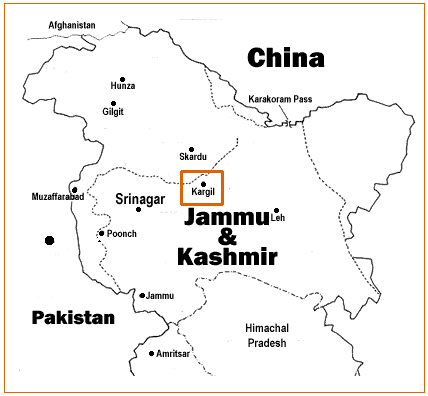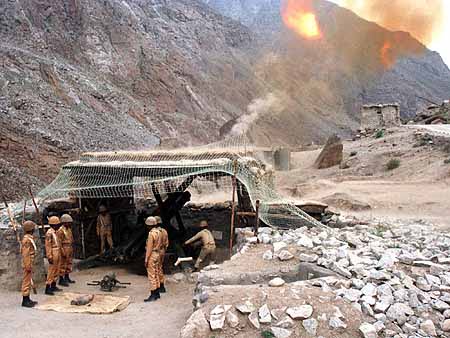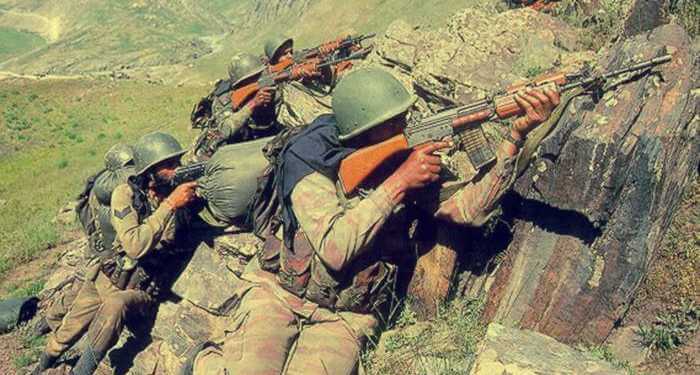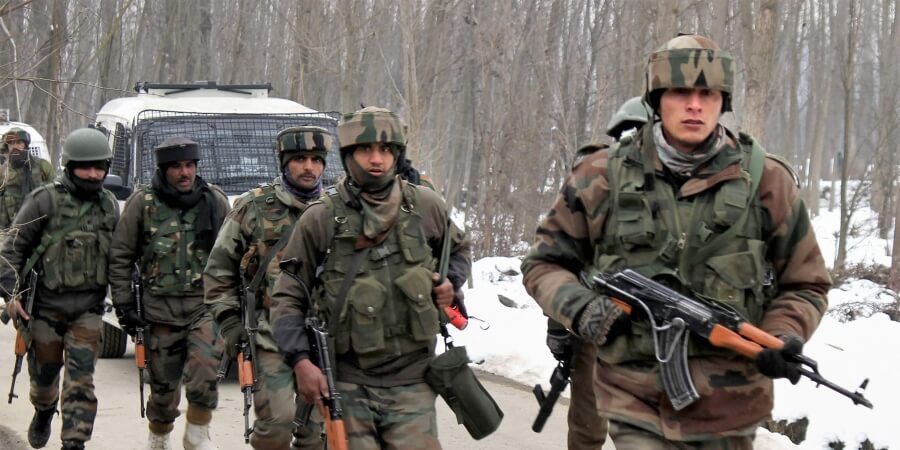The inside story : Mashkoh– Kargil as I saw it # 10
By
Brig Umesh Singh Bawa Vrc, SM

We analysed what had happened to B Company in the Saddle area near Point 4540 and implemented the lessons learnt. We revised our operating procedures and planning methodology to mitigate risk better. As a result of this tragic incident where we lost one JCO and five other ranks, we undoubtedly learnt our lessons. Since there was massive opposition on the eastern side, I decided to probe the south-eastern and south-western direction to the objective from a safe distance. This time I had decided to get detailed information about the enemy before making further exploitation.
Establishment of firm base by 17 Jat
On 30 May a fighting patrol from D company with one officer, one JCO and 20 other ranks led by Lt Shamsher Singh was sent on the south-eastern spur to watch the activities of the enemy on Point 4875 silently. The patrol positioned itself approximately 1500 meters from the objective. It gathered information by observation about the enemy strength and his routine. On the third day, Lt Shamsher Singh was able to report the movement of twelve to fifteen people; some were wearing black salwar suits. The patrol had by this time also concluded that it would be impossible to assault along the south-eastern spur due to steep gradient and opportunities for deployment were severely limited.
On 03 Jun, Major PS Janghu’s C company with 40 men staged forward on the south-western spur of Point 4875 to a point approximately 1000 meters short of it. They were tasked to keep the enemy under observation and assess their strength and suitability of assault along that approach. They reported that the complex was held by fifteen to twenty troops and their small arms fire and mortar fire was well coordinated. Also, they confirmed that the feature could be assaulted from the southwest direction. Regular fire exchange use to take place between the C Company and the enemy for days to come.

To provide cover fire to my patrols, I had deployed my mortar platoon in an open patch. For about a week, the targets were successfully engaged. Later, the mortars were picked up by the enemy, and within minutes, my mortar platoon was under enemy fire. They hurried to their alternate position, but they were fired upon by the enemy, once again. The enemy had gun/mortar locating radars, which enabled him to target our mortars/artillery gun positions with impunity. Unfortunately, we did not have such sophisticated mortar/gun locating radars and the enemy continued to fire at our mortar/gun positions with impunity.
Finally, I realised that the conventional method of deployment of mortars was not possible due to dominating heights held by the enemy. Therefore, I decided to deploy my mortar platoon unconventionally in ones and twos along the re-entrants, hugging the mountains, where the enemy guns and mortars couldn’t reach. All six tubes were deployed in an area of 20 meters by 30 meters. Although enemy guns and mortars tried to engage this mortar position number of times, his fire was not effective, and therefore it could render undisturbed fire support to the troops. After that, my mortars remained influential throughout the operations without the enemy being able to neutralise them.

By 05 Jun, we had encircled the enemy from three directions and established our firm base accordingly. In the east, Point 4540 was held by B Company (60 men); in the southeast, a patrol of D company (20 men) had established itself, and in the southwest C company (40 men) had firmed in. For the next twenty days, we kept the enemy under observation and harassed them with small arms fire and mortar fire. The enemy also did not allow us to sit tight. Every day, he would fire artillery shells on us twice / thrice a day, especially during meal times, when troops were out in the open! We did suffer some casualties, but in the bargain, my troops became battle-hardened and knew precisely how to take position themselves during enemy artillery shelling and avoid losses.
While all these activities were going on, my adjutant, Major HS Madan, was busy preparing recall notices for all the men who were on leave, informing them that their leave is cancelled. They should join the unit forthwith due to operational urgency.
Major Deepak Rampal, D company commander, was also on leave since early April and preparing for his staff college exams which were scheduled in Sep. I did not want to disturb his preparations/studies, and I thought I would send him the recall letter later when the operations were imminent. But at the beginning of Jun, I saw Major Deepak Rampal with his rucksack walk into our operational room, which was in a tent. I was quite surprised to see him as no recall letter was sent to him so far. I asked, “what made you come here as I was yet to send you a recall letter”. He informed me that he had heard on the radio news channel about the infiltrations in the Kargil sector. He read in the newspaper about the missing patrols of Lt Saurab Kalia and Capt Amit Bhardwaj and became certain that the situation in the Kargil sector was terrible. To add to this, he also saw coffins of brave soldiers- mostly belonging to Sikh and Punjab regiment deployed in the Kargil sector- returning to their homes in Punjab for the last time. All these developments touched Major Rampal, and he decided to cut short his leave and re-join the unit as he was sure that the battalion would be called over to take part in the operations. As a result, he immediately rang up the local army exchange in Srinagar to enquire about the movement of the unit. Due to security reasons, no information was divulged to him by the operator. Despite this, he left for Kashmir valley immediately as he wanted to be with the unit at this hour of crisis. After a lot of hustle-bustle during the long journey, he was finally able to locate and reach his battalion at Mashkoh valley.
All officers were pleasantly surprised to see him. I was particularly quite impressed by his singular voluntary act of dedication and devotion to duty which Major Rampal had displayed by voluntarily cutting short his leave. I did give his example to many other soldiers who were trickling in and joining the unit after getting their recall notice. It is the psyche of a soldier that plays on him during this period when all his comrades are on the battlefield, and he is away from the scene of action at home. He cannot bear this separation and desires to be in the scene of war with his men. He remains restless and feels the guilt of being away from the dangers of the battle area. This guilt forces a soldier to be part of the unit at such times of crisis.

The battalion had been employed in a counter-insurgency/counter-infiltration role before induction into the Mashkoh valley. Therefore, the men had to be re-oriented towards undertaking conventional offensive operations in high altitude area. A short capsule of two weeks of orientation training was prepared by the unit adjutant which was strictly followed.
At the beginning of the training cycle, I briefed all the officers separately and said, “It is often said there are no bad unit, only bad officers. The leaders must accept total responsibility for training the subunits they command. A subunit could only show exceptional performance in the war if the leader ensured that the subunit worked together towards a focused goal and ensured a high standard of training. Every member of the subunit should take the responsibility to take the subunit to a high level of training. It is not what you preach; it is what you tolerate. So, do not accept a sub-standard performance. Hold your subordinates accountable for the performance of the subunits. If you accept poor standards in training, that poor standard becomes a new standard. Therefore, leaders must enforce standards. Remember, the more you sweat during training, the less you bleed in war.”
The weapons were tested and fired by each individual so that he had confidence in his weapon. I wish to mention here that new 7.62 mm INSAS rifles were issued to me for the troops to replace the existing 7.62mm SLR. But my troops were trained in the handling of SLR. They were more comfortable with it rather than the untested INSAS. Therefore, we discarded these new weapons in favour of our existing 7.62 SLR. My commander was not happy with this decision. Still, I felt that the sentiments of troops have an overriding consideration while selecting their weapons, as ultimately it is the man behind the gun that matters and not just the weapon itself. If the new weapons were to be given to the troops, they should have been given at least six months in advance.
In the final analysis, we realised that Point 4875 was held by approximately 60-70 enemy soldiers as against the initial information provided to us about just 8-10 enemy troops. How wrong were we in our initial assessment? In the hindsight, I feel that had we carried out this assessment before launching B Company for operations, perhaps we could have saved few lives that we lost during the initial operations.
To know more about the Kargil war, read the book “Mashkoh: Kargil as I saw it”.



